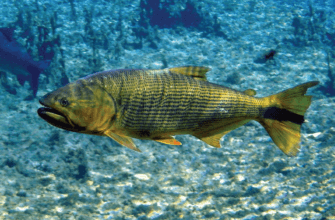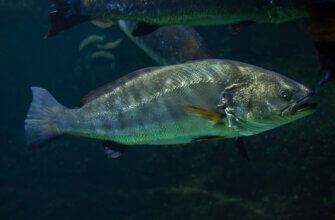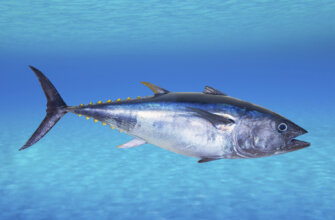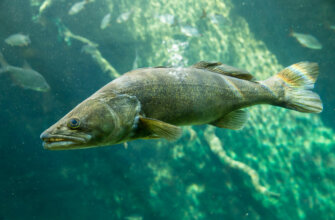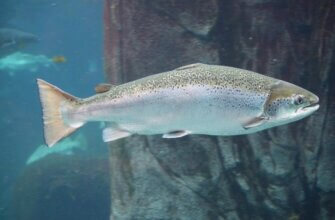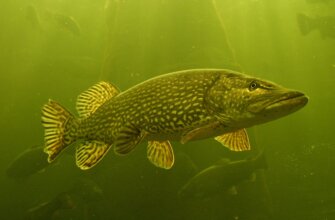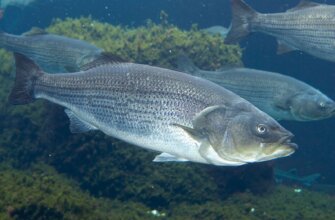Piranhas are a group of freshwater fish found in South America, known for their sharp teeth and predatory behavior. They belong to the family Characidae and are most commonly found in the Amazon Basin. Piranhas are known for their carnivorous diet and are often depicted as aggressive and dangerous in popular culture.
Fish have a deep, compressed body shape, with a distinctive triangular head and sharp teeth designed for ripping flesh. Piranhas are typically silver, gray, or reddish-brown in color, with some species having spots or stripes.
Despite their reputation as ferocious predators, piranhas generally feed on small fish, insects, and crustaceans. However, they have been known to attack humans in rare instances, usually when the water is low and food is scarce. In their natural habitat, piranhas play an important role in maintaining the balance of aquatic ecosystems.
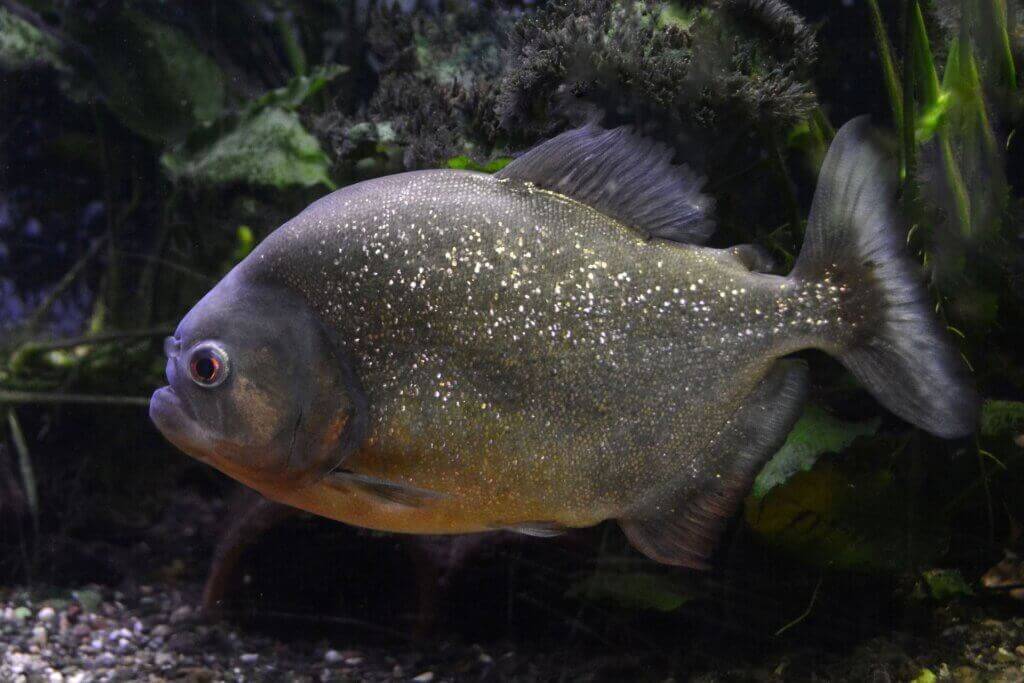
Species
There are more than 60 species of piranhas, ranging in size from about 5 inches (12.5 cm) to over 18 inches (45 cm) in length.
Here are some details about some of the most well-known species:
- Red-bellied piranha (Pygocentrus nattereri): This is one of the most common and widely recognized species of piranha. It has a robust body shape and a reddish or orange belly, giving it its name. Red-bellied piranhas are known for their sharp teeth and powerful bite.
- Black piranha (Serrasalmus rhombeus): The black piranha is one of the largest species. It has a dark gray or black coloration and a robust body. Black piranhas have extremely powerful jaws and teeth, allowing them to crush through shells and prey on a variety of vertebrates.
- Pygmy piranha (Pygopristis denticulata): Also known as the caribe or silver dollar piranha, the pygmy piranha is relatively smaller compared to other species. It has a silvery coloration and a laterally compressed body. Pygmy piranhas are known to travel in large schools and are less aggressive compared to other species.
- White piranha (Serrasalmus brandtii): The white piranha is a smaller species. It has a silvery-white coloration and a more elongated body shape compared to other piranhas. White piranhas are known for their sharp teeth and aggressive behavior, often displaying territoriality and dominance within their habitats.
It’s important to note that piranhas, regardless of species, have a carnivorous diet and possess sharp teeth designed for feeding on prey. While they do have a reputation for being aggressive, their behavior can vary depending on factors such as habitat conditions, availability of food, and human presence.
Appearance
Piranhas have several common physical features that are characteristic of the species as a whole.
Here are some key aspects of their appearance:
- Body Shape. Piranhas have a deep and laterally compressed body shape. This means that their bodies are tall from top to bottom and flattened from side to side. This body shape allows them to move swiftly through the water and change direction quickly.
- Coloration. Piranhas typically exhibit shades of silver, gray, or reddish-brown in their overall coloration. However, the exact colors and patterns can vary depending on the species. Some species may have spots, stripes, or other markings on their bodies, while others may have a more uniform coloration.
- Teeth. One of the most notable features of piranhas is their sharp teeth. Piranhas have triangular-shaped teeth that are interlocking and razor-sharp. Their teeth are well-suited for tearing flesh and consuming prey.
- Fins. Piranhas have several fins that aid in their locomotion. They typically have a dorsal fin on their back, an anal fin on their underside, and pectoral and pelvic fins on the sides of their body. These fins help them maintain stability and maneuver in the water.
Overall, piranhas have a streamlined and predatory appearance, with their sharp teeth and robust body shape being key characteristics. It’s important to note that specific physical traits can vary among different species of piranhas.
Size and weight
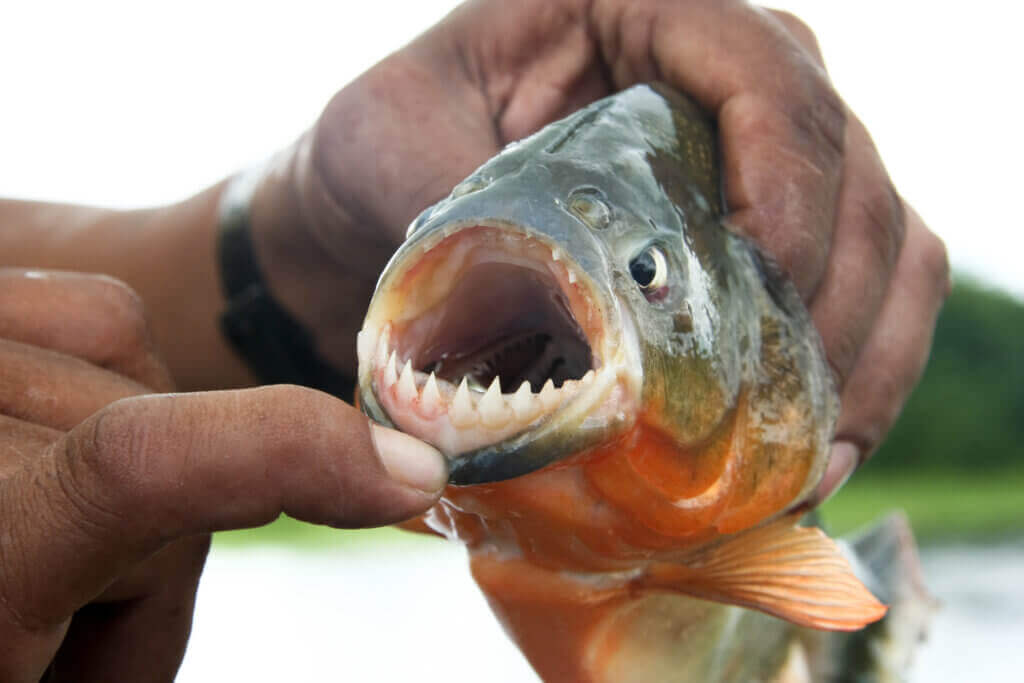
On average, piranhas are relatively small fish, with most species reaching lengths between 6 to 10 inches (15 to 25 centimeters). However, some larger species can grow up to 18 to 20 inches (45 to 50 centimeters) in length. The weight of piranhas also varies, but most individuals range from a few ounces to a couple of pounds.
It’s important to note that the size and weight of piranhas can be influenced by factors such as their age, habitat, and availability of food. Larger specimens are typically found in the wild, where they have access to abundant food sources and ample space to grow. In captivity, where food availability and tank size are limited, piranhas may not reach their maximum size.
Diet
Piranhas are carnivorous fish that primarily feed on a diet of other aquatic animals. While their sharp teeth and reputation for aggression may make them seem like voracious predators, their diet is actually quite diverse and includes a variety of food sources.
Here are some details about the diet of piranhas:
- Fish – fish make up a significant portion of a piranha’s diet. They prey on smaller fish that inhabit their freshwater habitats, such as smaller species of tetras, catfish, characins, and even other piranhas. Piranhas are opportunistic feeders and can quickly strip the flesh off a carcass, making them effective scavengers as well.
- Insects and Invertebrates – piranhas also consume insects and other invertebrates. They are known to feed on insects that fall into the water, as well as aquatic invertebrates such as crustaceans, mollusks, and small amphibians. This helps supplement their diet, especially when fish are less available.
- Plant Matter – although piranhas are primarily carnivorous, they are also known to consume plant matter on occasion. They may feed on algae, fruits, seeds, and aquatic plants, particularly during times when their preferred prey is scarce.
- Carrion – piranhas are scavengers and readily consume carrion, including the carcasses of larger animals that fall into the water. They can quickly strip the flesh from a carcass, utilizing their sharp teeth and powerful jaws.
It’s important to note that the diet of piranhas can vary depending on the specific species, their habitat, and the availability of food sources. While they are often depicted as ferocious and bloodthirsty, piranhas generally prefer to avoid humans and are not the indiscriminate predators they are sometimes portrayed to be.
Behavior
Piranhas exhibit various behaviors that help them survive and thrive in their freshwater habitats.
Here are some key details about the behavior of piranhas:
- Schooling Behavior. Piranhas are known for their schooling behavior, where they gather in large groups called shoals. This behavior provides them with several advantages, including increased protection against predators, improved hunting efficiency, and social interaction. By swimming in a tight formation, they can coordinate their movements and respond to threats more effectively.
- Feeding Behavior. While piranhas are often associated with aggressive feeding frenzies, their feeding behavior is more nuanced. They are opportunistic feeders and primarily feed on smaller fish, insects, and other prey items. When food is scarce, they may become more aggressive and exhibit frenzied feeding behavior. However, most of the time, they rely on stealth and ambush tactics to catch their prey.
- Territoriality. Piranhas can be territorial, especially during the breeding season or when resources are limited. They may defend their preferred feeding and spawning areas from other piranhas. Aggressive displays, such as fin displays and chasing, are common during territorial disputes. However, territoriality varies among species, and some piranhas may exhibit more territorial behavior than others.
- Reproductive Behavior. During the breeding season, piranhas engage in courtship displays and mate to reproduce. They often lay their eggs in nests, which are usually built by the male piranha. The male guards and protects the eggs until they hatch. After hatching, the young piranhas form schools and stay close to their parents for a period before becoming independent.
- Communication. Piranhas communicate with each other through various visual and auditory signals. Visual displays, such as changing body coloration and fin movements, are used to convey information about aggression, mating readiness, and territoriality. They can also produce low-frequency sounds and drumming noises by vibrating their swim bladder, which may serve as a form of communication.
- Nocturnal Activity. Some species of piranhas are more active during the night, while others are diurnal, meaning they are active during the day. Nocturnal piranhas rely on their well-developed senses to navigate and hunt in low-light conditions.
It’s important to note that the behavior of piranhas can vary among species and individuals. While they have a reputation for aggression, they typically avoid confrontations with larger animals, including humans, unless they feel threatened or provoked.
Spawning
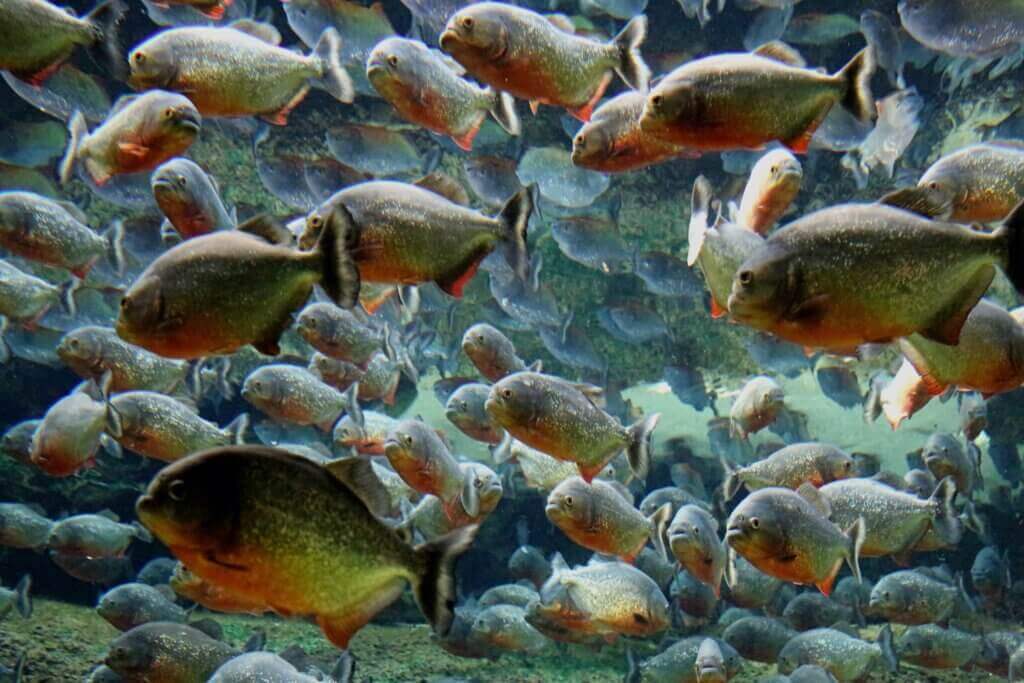
Spawning, or the reproductive process, in piranhas involves various behaviors and strategies to ensure successful reproduction.
Here are some details about the spawning behavior of piranhas:
- Breeding Season: Piranhas typically have a specific breeding season, which can vary depending on the species and environmental factors. This period is usually associated with favorable conditions such as temperature, water levels, and food availability.
- Courtship Displays: Prior to mating, piranhas engage in courtship displays to attract mates and establish breeding pairs. These displays can involve various behaviors, such as fin displays, head-shaking, chasing, and nipping. Brighter body coloration and intensity of displays often indicate readiness for mating.
- Nest Building: In many piranha species, it is the male piranha that takes the responsibility of building a nest for egg deposition. The male uses his mouth to clear an area, usually on the substrate or among aquatic vegetation, and creates a nest. The nest is typically a shallow depression where the female will deposit her eggs.
- Spawning Behavior: Once the nest is ready, the female piranha approaches the male, and they engage in a spawning act. The female releases her eggs, while the male releases sperm to fertilize them. This process is often repeated multiple times to ensure successful fertilization.
- Parental Care: After spawning, parental care in piranhas varies among species. In some species, the male piranha guards and protects the eggs by fanning them with his fins to provide oxygen and prevent fungal growth. He may also defend the nest against intruders. In other species, both parents may contribute to the care of eggs or juveniles.
- Hatching and Juvenile Stage: The incubation period of piranha eggs can range from a few days to a couple of weeks, depending on the species and environmental conditions. Once the eggs hatch, the young piranhas, known as fry, are typically free-swimming and form schools. They may stay close to their parents for protection and guidance until they become independent.
It’s important to note that the specifics of piranha spawning behavior can vary among species, and some details may differ depending on the specific environment and conditions in which they live. Additionally, piranhas generally prefer to breed in calm, secluded areas to minimize disturbances and maximize the chances of successful reproduction.
Fishing
Fishing for piranhas can be a popular activity in some regions, especially in South America where they are native.
Here are some details about fishing for piranhas:
- Equipment: When fishing for piranhas, it is common to use basic fishing equipment such as a fishing rod, reel, and fishing line. A lightweight spinning rod with a strong line is typically sufficient for piranha fishing. It’s advisable to use a steel or braided fishing line as piranhas have sharp teeth that can easily cut through traditional monofilament lines.
- Bait and Lures: Piranhas are attracted to a variety of bait and lures. Live bait is often effective, such as small fish or pieces of meat, as the movement and scent can entice piranhas to strike. Popular bait options include small pieces of fish, chunks of meat, or even live insects. Artificial lures such as spoons, spinners, and soft plastic baits can also be used to mimic prey and attract piranhas.
- Techniques: One common technique for piranha fishing is using a float or bobber setup. This involves suspending the baited hook below a float and allowing it to drift or remain stationary in the water. Another popular technique is casting and retrieving, where the angler casts the bait or lure and retrieves it with varying speeds and movements to entice strikes.
- Location: Piranhas are typically found in freshwater bodies such as rivers, lakes, and streams in South America. They are often found in areas with vegetation, submerged logs, and structures where they can hide and ambush prey. Locals or experienced guides familiar with the area can provide valuable insights into productive fishing spots for piranhas.
- Safety Precautions: While piranhas have a reputation for aggression, they are generally not a significant threat to humans if proper precautions are taken. However, it’s important to handle them with care as they have sharp teeth and strong jaws. Using pliers or specialized tools to handle the fish can help avoid injuries. Additionally, it is advisable to avoid fishing in piranha-infested waters if you have open wounds to minimize the risk of attracting their attention.
It’s worth noting that regulations and guidelines for fishing piranhas can vary depending on the location and local laws. It is essential to check and adhere to the fishing regulations in the specific area you plan to fish in and consider practicing responsible and sustainable fishing practices to conserve the populations of piranhas and their ecosystems.
Lures
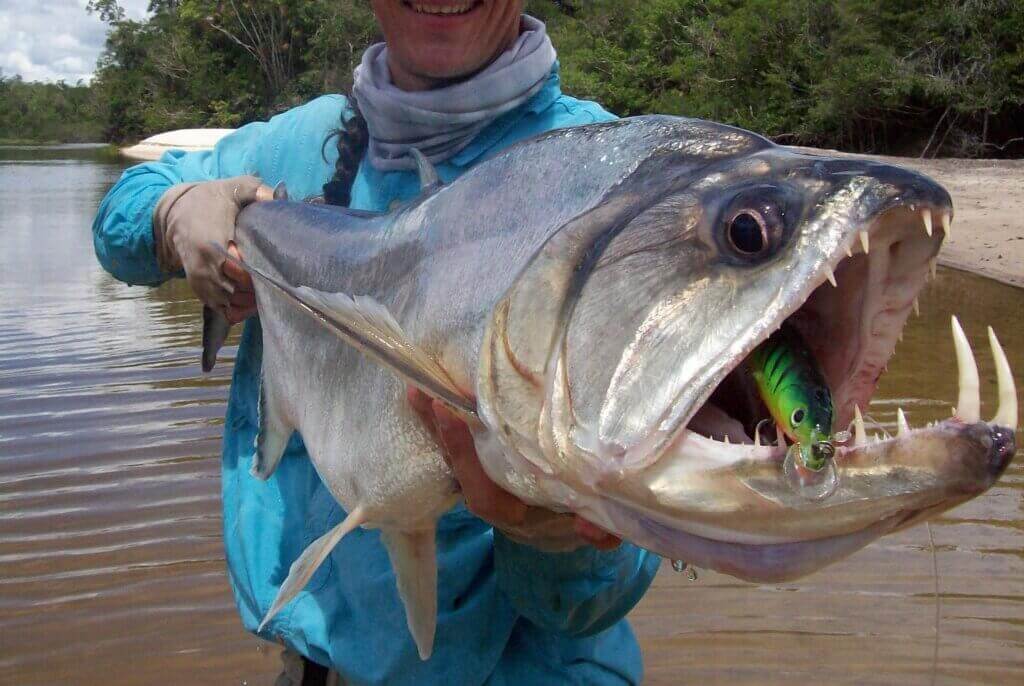
When fishing for piranhas, various types of lures can be effective in attracting their attention and enticing them to strike.
Here are some details about lures commonly used for piranha fishing:
- Spoons: Spoons are popular lures for piranha fishing due to their flash and wobbling action. These metal lures are shaped like a spoon and have a concave surface that reflects light and creates a fish-attracting flash. The wobbling motion imitates injured prey, making them a tempting target for piranhas.
- Spinners: Spinners consist of a spinning blade attached to a wire shaft with a hook. When retrieved, the spinning blade creates vibrations and flash, which can mimic the movements of small fish. The combination of visual and auditory stimulation can trigger aggressive strikes from piranhas.
- Soft Plastic Baits: Soft plastic baits, such as rubber worms, grubs, or minnow imitations, can also be effective for piranha fishing. These lures often have lifelike appearances and realistic swimming actions when retrieved through the water. Using brightly colored soft plastics can help attract piranhas’ attention in murky or stained waters.
- Topwater Lures: Topwater lures are designed to be fished on the water’s surface, creating commotion and attracting attention from piranhas. These lures, such as poppers or prop baits, mimic injured or struggling prey on the water’s surface, which can trigger aggressive strikes from piranhas.
- Fly Fishing Flies: Fly fishing for piranhas can be an exciting and challenging technique. Various fly patterns imitating small baitfish, insects, or streamers can be effective. Brightly colored flies with flash or materials that create movement can help catch the attention of piranhas.
- Natural Baits: While lures are commonly used for piranha fishing, natural baits can also be effective. Pieces of fish, shrimp, or meat are often used as bait, either live or dead. The scent and movement of natural baits can attract piranhas and trigger strikes.
When selecting lures for piranha fishing, it’s generally advisable to choose smaller sizes to match the size of their prey and their relatively small mouths. Additionally, using sharp and sturdy hooks is important since piranhas have strong jaws and sharp teeth that can damage or break weak hooks.
It’s essential to consider local regulations and restrictions on bait and lure usage, as well as practicing catch-and-release or following any other conservation guidelines to protect the piranha population and their habitats.
Here are a few examples of fishing lures that are commonly used for piranha fishing, along with their models and specifications:
- Johnson Silver Minnow Spoon:
- Model: Johnson Silver Minnow Spoon.
- Specifications: This spoon lure features a silver-plated body with a concave shape that produces a fish-attracting flash. It has a single hook and a weedless design, making it suitable for fishing in vegetation-rich areas where piranhas may be hiding.
- Mepps Aglia Spinner:
- Model: Mepps Aglia Spinner.
- Specifications: The Mepps Aglia Spinner is a popular choice for piranha fishing. It comes in various sizes, typically ranging from 1/8 ounce to 1/4 ounce. It features a spinning blade, a treble hook, and a dressed tail. The blade creates vibrations and flash, while the dressed tail adds additional attraction.
- Yo-Zuri Crystal Minnow:
- Model: Yo-Zuri Crystal Minnow.
- Specifications: The Yo-Zuri Crystal Minnow is a suspending jerkbait lure that mimics the appearance and action of small baitfish. It has a durable and translucent body with holographic finishes that reflect light and attract piranhas. The lure typically ranges from 3 to 4 inches in length.
- Rebel Pop-R Topwater Lure:
- Model: Rebel Pop-R Topwater Lure.
- Specifications: This topwater lure is designed to create surface commotion and imitate struggling prey. It features a cupped face that produces a popping and splashing sound when retrieved. The Rebel Pop-R is available in different sizes, typically ranging from 2 to 3.5 inches.
- Rapala X-Rap:
- Model: Rapala X-Rap.
- Specifications: The Rapala X-Rap is a versatile minnow-style bait that works well for piranha fishing. It has a realistic design, 3D holographic eyes, and a swimming action that imitates wounded baitfish. The lure comes in various sizes, typically ranging from 2 to 4 inches.
Please note that specific models, sizes, and specifications may vary depending on the manufacturer and availability. It’s always a good idea to consult with local anglers, fishing guides, or bait and tackle shops in the region where you plan to fish for piranhas to get recommendations on effective lures based on their experience and the local conditions.
Baits
When fishing for piranhas, using various types of baits can be effective in attracting their attention and enticing them to bite.
Here are some details about baits commonly used for piranha fishing:
- Live Bait: Live bait is often a productive choice for piranha fishing as it mimics the natural movement and scent of prey. Small live fish, such as minnows, tetras, or shiners, can be used as bait. You can hook them through the lips or back to allow them to swim freely and attract piranhas.
- Dead Bait: Dead bait can also be effective for piranha fishing. Small pieces of fish, such as chunks or fillets, can be used as bait. The scent of the decomposing fish can attract piranhas to the area. Make sure to use fresh or preserved dead bait to ensure maximum effectiveness.
- Meat: Piranhas are attracted to the smell of meat, and using pieces of meat as bait can be productive. Options like beef, chicken, or pork can be cut into small chunks or strips and used as bait. You can thread them onto the hook or use them in combination with other bait options.
- Shrimp: Fresh or frozen shrimp can be effective bait for piranhas. The scent and movement of shrimp can attract piranhas and entice them to bite. Use whole or cut pieces of shrimp, and secure them on the hook.
- Insects: Piranhas are opportunistic feeders and will readily go after insects that fall into the water. Using live or artificial insects, such as grasshoppers, crickets, or mealworms, can be effective. They can be hooked through the body or used on a small hook with a float setup.
- Scented Baits: Adding scent to your bait can help attract piranhas, especially in murky or stained water conditions. You can use commercial fish attractant sprays or apply scents such as anise, garlic, or shrimp oil to enhance the attractiveness of your bait.
It’s important to note that the effectiveness of different bait options can vary depending on the location, time of year, and specific preferences of piranhas in the area. It’s always a good idea to consult with local anglers, fishing guides, or bait and tackle shops to get recommendations on effective baits based on their experience and the local conditions. Additionally, be sure to comply with any regulations regarding the use of live bait or specific bait restrictions in the area you are fishing.
Rods
When fishing for piranhas, it’s important to select a fishing rod that is suitable for the task.
Here are some details about fishing rods commonly used for piranha fishing:
- Spinning Rods: Spinning rods are a popular choice for piranha fishing due to their versatility and ease of use. They are available in various lengths and power ratings. A spinning rod with a length between 6 to 7 feet (1.8 to 2.1 meters) is commonly used for piranha fishing. The power rating can vary depending on the size of piranhas and the fishing conditions. Medium to medium-heavy power rods are often suitable for piranha fishing.
- Baitcasting Rods: Baitcasting rods can also be used for piranha fishing, especially when targeting larger or more aggressive species. Baitcasting rods provide more power and accuracy in casting, making them suitable for casting heavier baits or lures. They are typically shorter and sturdier than spinning rods, ranging from 5.5 to 6.5 feet (1.7 to 2 meters) in length.
- Material: Fishing rods are commonly made of graphite or fiberglass, or a combination of both materials. Graphite rods are lightweight, sensitive, and offer excellent responsiveness, making them suitable for detecting subtle bites. Fiberglass rods, on the other hand, are more durable and have more flex, providing better strength and control when battling powerful fish like piranhas.
- Action: The action of a fishing rod refers to how much the rod bends when pressure is applied to the tip. Fast action rods bend mostly in the upper third or quarter of the rod, while moderate or slow action rods bend more towards the middle or lower sections. For piranha fishing, a fast or medium-fast action rod is generally preferred as it allows for better hook sets and control when fighting aggressive fish.
- Line Weight and Lure Weight: Fishing rods have specifications for the line weight and lure weight they can handle. For piranha fishing, a rod with a line weight rating of around 6 to 12 pounds (2.7 to 5.4 kilograms) is commonly used. The lure weight rating can vary depending on the size of the lures you plan to use, but typically ranges from 1/8 to 1/2 ounce (3.5 to 14 grams).
- Guides and Reel Seat: Look for fishing rods with quality guides (the small rings along the rod) that are designed to handle the strain of fishing lines. Additionally, a sturdy reel seat is important to securely hold the fishing reel in place.
It’s worth noting that these specifications can vary depending on personal preferences, fishing conditions, and the specific species of piranhas you are targeting. When selecting a fishing rod for piranha fishing, consider the size of the fish you expect to catch, the type of water you’ll be fishing in, and the techniques you plan to use. Consulting with local anglers or fishing tackle experts familiar with piranha fishing in your specific location can provide valuable insights and recommendations.
Here are a few examples of fishing rods commonly used for piranha fishing, along with their models and specifications:
- Ugly Stik Elite Spinning Rod:
- Model: Ugly Stik Elite Spinning Rod.
- Specifications: This spinning rod is known for its durability and sensitivity. It is made with a combination of graphite and fiberglass, providing a balance of strength and responsiveness. It is available in various lengths and power ratings, ranging from ultralight to heavy. The Ugly Stik Elite Spinning Rod is known for its affordability and reliability.
- Abu Garcia Veritas Baitcasting Rod:
- Model: Abu Garcia Veritas Baitcasting Rod.
- Specifications: The Abu Garcia Veritas is a lightweight and sensitive baitcasting rod that offers excellent casting accuracy and control. It features a graphite construction with a strong backbone and a fast action tip. It is available in different lengths and power ratings to suit different fishing preferences.
- Shimano Sojourn Spinning Rod:
- Model: Shimano Sojourn Spinning Rod.
- Specifications: The Shimano Sojourn is a versatile spinning rod suitable for piranha fishing. It is constructed with a graphite composite blank that provides a good balance of sensitivity and strength. It comes in various lengths and power ratings, offering options for different fishing conditions and techniques.
- St. Croix Triumph Spinning Rod:
- Model: St. Croix Triumph Spinning Rod.
- Specifications: The St. Croix Triumph is a high-quality spinning rod known for its performance and durability. It features a premium graphite construction that offers sensitivity and responsiveness. It is available in different lengths and power ratings to accommodate various fishing styles and target species.
- Shakespeare Ugly Stik GX2 Baitcasting Rod:
- Model: Shakespeare Ugly Stik GX2 Baitcasting Rod.
- Specifications: The Ugly Stik GX2 Baitcasting Rod is a reliable and affordable option for piranha fishing. It features a combination of graphite and fiberglass construction, providing strength and durability. It has a medium-heavy power rating and a fast action, making it suitable for handling piranhas and casting heavier baits.
These are just a few examples of fishing rods commonly used for piranha fishing. When selecting a fishing rod, consider factors such as your fishing style, target species, and personal preferences. It’s always recommended to visit local tackle shops or consult with experienced anglers who are familiar with the fishing conditions and piranha behavior in your specific location to get more tailored recommendations.
Dishes
Piranha is a type of freshwater fish known for its sharp teeth and carnivorous diet. While piranhas are often associated with their fierce reputation, they are also consumed as food in certain regions where they are found.
Here are some details about dishes made with piranha:
- Grilled Piranha. Grilled piranha is a popular preparation method for this fish. The piranha is typically cleaned, marinated with spices or herbs, and then cooked over an open flame or on a grill. The grilling process imparts a smoky flavor and helps to crisp up the skin, resulting in a flavorful and tender fish.
- Fried Piranha. Another common way to prepare piranha is by frying it. The cleaned piranha is typically coated with a seasoned flour or breadcrumb mixture and then deep-fried until golden brown and crispy. This method helps to retain the natural flavors of the fish while providing a crispy texture.
- Piranha Soup. Piranha soup is a popular dish in some regions. The fish is usually simmered in a flavorful broth along with vegetables, herbs, and spices. The soup is often hearty and rich in flavors, and the piranha meat becomes tender and easily flakes apart.
- Ceviche. Ceviche is a dish where raw fish is marinated in citrus juice, typically lime or lemon juice, which “cooks” the fish through the acid in the juice. Piranha can be used to make ceviche, and the acid in the citrus juice helps to firm up the flesh and enhance its flavor. Other ingredients such as onions, peppers, and herbs are often added to create a refreshing and tangy dish.
- Stewed Piranha. Stewed piranha involves slow-cooking the fish in a flavorful liquid or sauce. The fish is often simmered with vegetables, herbs, spices, and sometimes coconut milk or tomato-based sauces. This method allows the flavors to meld together, resulting in a rich and savory dish.
It’s worth noting that the preparation methods and dishes can vary depending on the region and local culinary traditions. In regions where piranhas are commonly consumed, you may find additional regional specialties and variations of dishes made with piranha.
When handling and preparing piranha for consumption, it is important to ensure that the fish is properly cleaned and cooked to eliminate any potential health risks. Additionally, be aware of local fishing regulations and guidelines to support sustainable fishing practices and protect the natural habitats of piranhas.

